|
|
 |
|
Calanoida ( Order ) |
|
|
|
Clausocalanoidea ( Superfamily ) |
|
|
|
Euchaetidae ( Family ) |
|
|
|
Paraeuchaeta ( Genus ) |
|
|
| |
Paraeuchaeta rasa Farran, 1929 (F,M) | |
| | | | | | | Syn.: | Pareuchaeta rasa Farran, 1929 (p.208, 240, Descr.F, figs.F); no Pareuchaeta rasa : C.B. Wilson, 1950 (p.283); Mauchline, 1998 (tab.42);
Euchaeta rasa : Vervoort, 1957 (p.77, 78, figs.F, Rem.); Park, 1978 (p.272, figs.F, M, Rem.); Øresland & Ward, 1993 (p.73, diet);
Ref. compl.: Hopkins, 1985 (p.197, Table 1, gut contents); Hopkins & Torres, 1988 (tab.1); Ward & Wood, 1988 (p.45, tab.1) | | | | Ref.: | | | Bradford & al., 1983 (p.51, figs.F,M, Rem.); Razouls, 1994 (p.95, figs.F, M, Rem.); Park, 1994 (p.321); 1995 (p.46, Rem.F,M, figs.F,M); Bradford-Grieve & al., 1999 (p.880, 926, figs.F) | 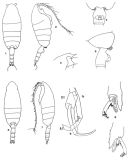 issued from : Park T.-S. in Antarct. Res. Ser. Washington, 1978, 27: 91-290. As Euchaeta rasa. Female: 1, 2, habitus ((dorsal , lateral); 3, Rostrum (lateral); 4, genital segment (lateral). Male: 6, 7, habitus (dorsal, lateral); 8, P5 (Dt: right, G: left); 9, distal exopodite of left P5.
|
 issued from : G.P. Farran in British Antarctic (\"Terra Nova\") Expedition, 1910. Natural History Reports. Zoology. Vol. VIII. Crustacea, 1929. [p.241, Fig.10]. Female: a, rostrum; b, genital segment (left lateral view); c, urosome (ventral view); d, genital plates (ventral view); e, first foot; f, third joint of exopodite of second foot.
|
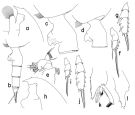 issued from : T. Park in Bull. Scripps Inst. Oceanogr. Univ. California, San Diego, 1995, 29. [p.145, Fig.35]. Female: a, forehead (left side); b, urosome (left); c, genital somite (left); d, idem (left, tilted counterclockwise); e, Mx1 (first inner lobe omitted), posterior; f, exopod of P1 (anterior); g, exopod of P2 (anterior). Nota: Similar in habitus to P. scotti and P.aequatorialis. Laterally, forehead anterior to suprafrontal sensilla almost straight; Urosome relatively slender. Dorsal wall of genital somite with a large hump posterior to middle. Posterior lobe of genital flange and posterior edge of genital field about on same level. Posterior margin of genital prominence aboyt 1/3 length of posterior ventral wall of somite and almost perpendicular to it. Posterior ventral wall of somite strongly bulging. A low, rounded ridge close to anterior margin of genital prominence and a similar ridge close to posterior margin on each side of genital somite. Cephalosomal appendages similar to those of P. aequatorialis with a minor exception that 1st endopodal segment of Mx1 carrying 6 or 7 setae. Male: h, forehead (left); i, exopod of P1 (anterior); j, exopod of P2 (anterior); k, distal exopodal segments of left 5th leg (lateral, tilted clockwise); l, serrated lamella of left 5th leg exopod (anterior, tilted counterclockwise).
|
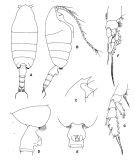 issued from : T. Park in Antarctic Res. Ser. Washington, 1978, 27. [p.273, Fig.113]. As Euchaeta rasa. Female: A, habitus (dorsal); B, idem (right side); C, forehead (lateral); D, E, last metasomal and genital segments (lateral and ventral, respectively); F, P1; G, P2. P1-2: legs (anterior). Nota from Bradford & al. (1983, p.51): - P1 exopod female: Bb = 1/2 BC; Cc > BC. - P2 exopod female: Aa = Ab; Bb = 1/2 BC; Cc = 6/1 CD; Dd = 1/3 CD. (see code of lengths outer spines in the Genus' figure, or in Paraeuchaeta sp. A).
|
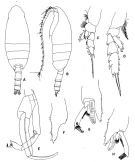 issued from : T. Park in Antarctic Res. Ser. Washington, 1978, 27. [p.274, Fig.114]. As Euchaeta rasa. Male: A, B, habitus (dorsal and lateral, respectively); C, P1; D, P2; E, P5; F, serrated lamella of left P5 (anterolateral); G, H, distal part of exopod of left P5 (medial and anterolateral, respectively). P1-P5: legs (anterior). Nota from Bradford & al. (p.51): - P1 exopod male: Bb = 1/3 BC; Cc = 1/2 BC. - P2 exopod male: Aa = 1/4 AB; Bb = 1/3 BC; Cc = 1/2 CD; Dd = 1/3 CD. (see code of lengths outer spines in the Genus' figure, or in Paraeuchaeta sp. A).
|
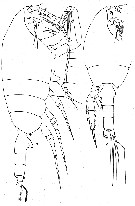 issued from : W. Vervoort in B.A.N.Z. Antarctic Reseach Expedition, Report Ser. B, Vol. III., 1957 [Fig.58]. As Euchaeta rasa. Female (from 66°30'S, 61°08'E): a, habitus (lateral); b, forehead (lateral); c, posterior part cephalothorax and urosome (dorsal). Rostrum slender and tapers gradually into a fine point, directed obliquely forwards.
|
 issued from : W. Vervoort in B.A.N.Z. Antarctic Reseach Expedition, Report Ser. B, Vol. III., 1957 [Fig.59]. As Euchaeta rasa. Female: a-c, genital somite (lateral; right side and left side, respectively); b, posterior part cephalothorax and urosome (lateral). Nota: The genital flaps are not fully symmetrical; the left flap is slightly smaller and less evenly rounded than that on the right side; the caudal slope of the genital elevation, near the base of the flaps, has a strong, chitinous, transverse ridge.
|
 Paraeuchaeta rasa Paraeuchaeta rasa Female: 1 - See key to species Groups and independent species of Paraeuchaeta (p.30): malayensis species Group. 2 - Outer spine of 2nd exopodal segment (or the 2nd of the first 2 exopodal segments forming a proximal, compound segment) of P1 normally developed (Fig.35-f). 3 - Outer lobe of Mx1 with 5 long setae (Fig.35-e). 4 - Laterally, genital prominence low with more or less convex genital flanges. 5 - Laterally, rostrum well developed (Fig.35-a). 6 - Laterally, posterior margin of genital prominence distinct from posterior ventral wall of somite (Fig.35-c). 7 - Genital somite without conspicuous conical process on left side (Fig.35-c). 8 - Laterally, genital prominence with 2 conspicuous semi-circular ridges (Fig.35-c).
|
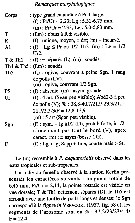 Issued from : C. Razouls in Ann. Inst. océanogr., Paris, 1994, 70 (1). [p.95]. Caractéristiques morphologiques de Paraeuchaeta rasa femelle et mâle adultes. Terminologie et abbréviations: voir à Calanus propinquus.
| | | | | Compl. Ref.: | | | Sewell, 1948 (p.574); Errhif & al., 1997 (p.422); Razouls & al., 2000 (p.343, tab. 3, 5, Appendix); Ward & Shreeve, 2001 (p.50, tab. 4); Schnack-Schiel & al., 2008 (p.1045: Tab.2); Park & Ferrari, 2009 (p.143, Table 3, 7: common deep water species, 8, fig.1, Appendix 1, biogeography); Laakmann & al., 2009 (p.679, fig.2, 4, Table 2); Laakmann & al., 2012 (p.535, Table 1, fig.2, Rem.: mol. Biol.) | | | | NZ: | 6 | | |
|
Distribution map of Paraeuchaeta rasa by geographical zones
|
| | | | | | | | | 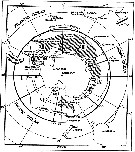 issued from : W. Vervoort in B.A.N.Z. Antarctic Reseach Expedition, Reports - Ser. B, Vol. III, 1957 [Fig.57]. As Euchaeta rasa. issued from : W. Vervoort in B.A.N.Z. Antarctic Reseach Expedition, Reports - Ser. B, Vol. III, 1957 [Fig.57]. As Euchaeta rasa.
Chart showing the geographical distribution (white triangle) in the seas surrounding the Antarctic continent.
Nota: In this chart the area frequented by whaling vessels has been hatched. The Antarctic circle (66°.5 S) has been drawn as a broken line. The numbers I to VI refer to the sectors into which the Antarctic seas are divided according to Mackintosh (1942) (after Vervoort, 1951). |
 issued from : T. Park in Biology of the Antarctic Seas VII. Antarctic Res. Ser., 1978, 27 (4). [p.259, Fig.104]. issued from : T. Park in Biology of the Antarctic Seas VII. Antarctic Res. Ser., 1978, 27 (4). [p.259, Fig.104].
Occurrence of Euchaeta ( = Paraeuchaeta ) rasa.
Closed circles: stations where the species was found; A.C: Antarctic Convergence. |
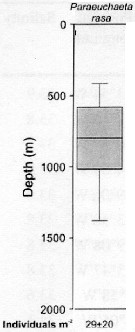 issued from : S. Laakmann, M. Stumpp & H. Auel in Polar Biol., 2009, 32. [p.682, Fig.2]. issued from : S. Laakmann, M. Stumpp & H. Auel in Polar Biol., 2009, 32. [p.682, Fig.2].
Vertical distribution (stages C3 to C6 from Antarctic Polar Front: Atlantic sector).
Error bars encompass the 5th to the 95th percentile. Abundance data are given as mean ± SD.
This species and P.biloba co-occured within the same depth range, and overlapped in their ranges with P. antarctica. |
| | | | Loc: | | | Antarct. ( Weddell Sea, SW Atlant., Indian, SW & SE Pacif., Croker Passage), South Georgia, sub-Antarct. (SW & SE Atlant., SE Pacif.), S Indian (subtropical convergence), Atlant. (SE & SW), Chile | | | | N: | 16 | | | | Lg.: | | | (3) F: 6,4-5,8; M: 5,8-5; (20) F: 6,75-5,31; M: 5,83-5; (25) F: 6,08-5,88; (35) F: 6-5,8; {F: 5,31-6,75; M: 5,00-5,83} | | | | Rem.: | Meso-bathypelagic.
Sampling depth (Antarct., sub-Antarct.) : 0-600-4000 m.
For Vervoort (1957, p.78) this species is characterized by the structure of the genital somite; the left side of the genital swelling carries 2 chitinous riges that give the genital somite a peculiar appearance when seen from the left side.
According to Vervoort, C.B. Wilson (1950, p.283) mentions female and male specimens of P. rasa Farran from the East Pacific, that are certainly not identical with Farran's species.
Park (1995, p.46) found this species in south of 47°S in the Pacific and Indian oceans, but in the southeastern Atlantic it was found as far north as 31°S. | | | Last update : 27/01/2017 | |
|
|
 Any use of this site for a publication will be mentioned with the following reference : Any use of this site for a publication will be mentioned with the following reference :
Razouls C., Desreumaux N., Kouwenberg J. and de Bovée F., 2005-2025. - Biodiversity of Marine Planktonic Copepods (morphology, geographical distribution and biological data). Sorbonne University, CNRS. Available at http://copepodes.obs-banyuls.fr/en [Accessed August 23, 2025] © copyright 2005-2025 Sorbonne University, CNRS
|
|
 |
 |














